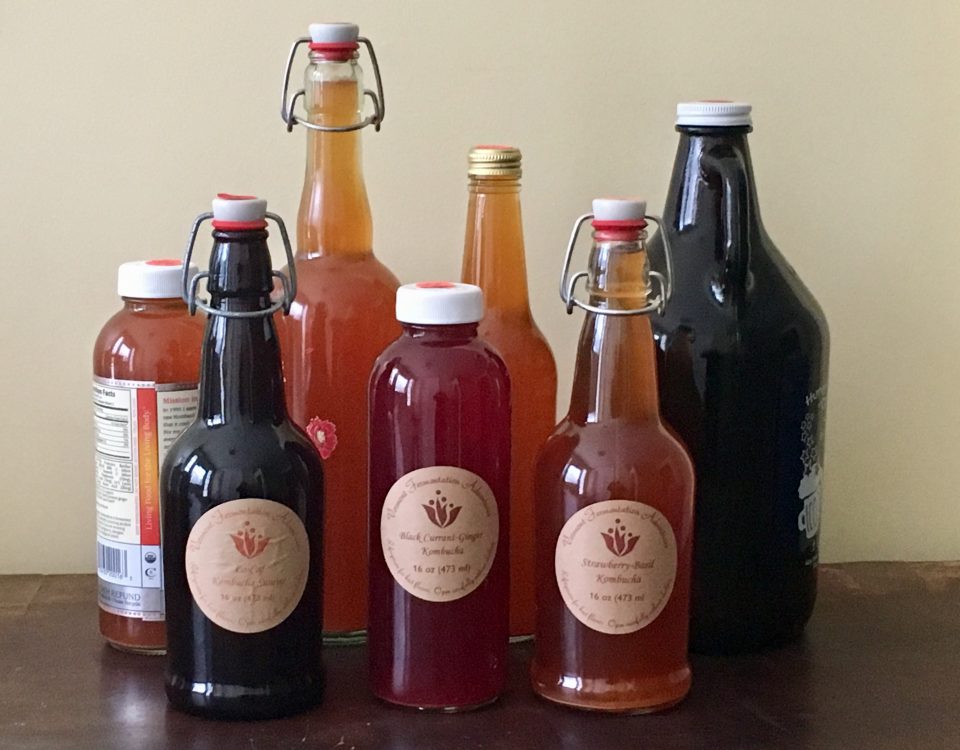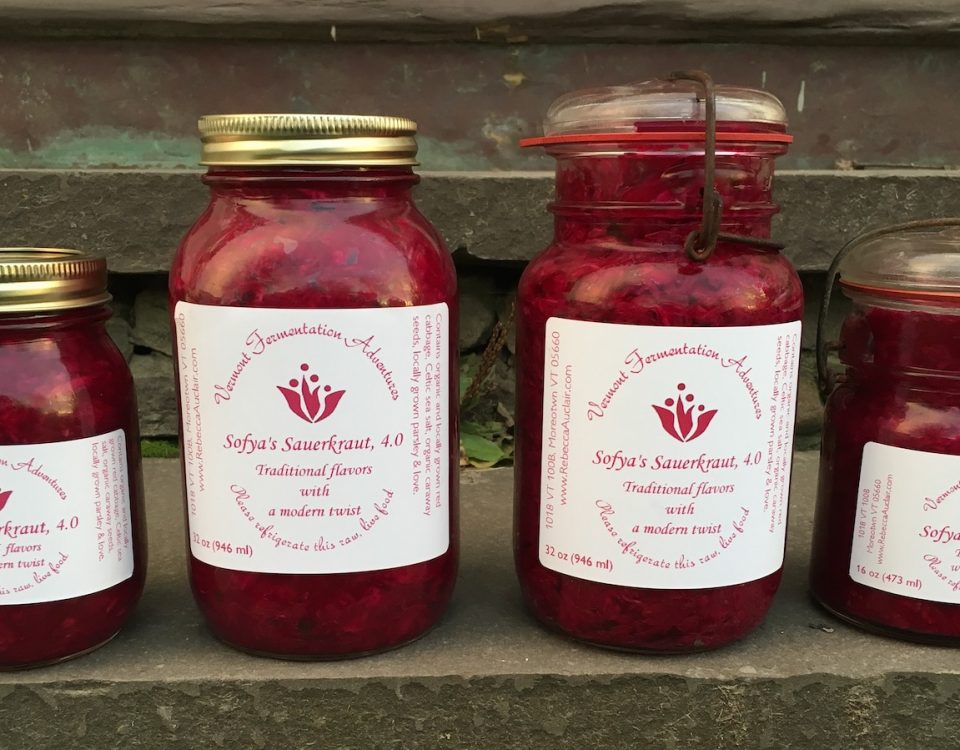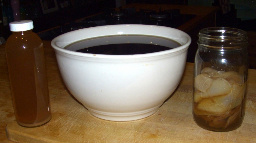
A kombucha mother in a bowl with kombucha
Ingredients for one gallon of kombucha:
- One gallon non-chlorinated water
- One cup sugar
- One-half cup plain, raw kombucha
- Four tablespoons black tea leaves or four black tea bags
- One kombucha mother
Notes about ingredients:
I use pure, well water. Water is the main ingredient in kombucha. Even though the water will be boiled and cooled before it comes into contact with the yeasts and bacteria, it is best if the water you begin with is as clean as possible. Consider using bottled or filtered water if your tap water has lots of chemicals in it or if it is heavy with minerals.
I use organic, unbleached sugar which might be a kombucha-making faux pas. Some people contend that white, bleached sugar is an essential ingredient in producing authentic kombucha. Ew. I just can’t go there. The white sugar defenders reassure us that the yeasts and bacteria digest the harmful trace chemicals in white sugar (and I ask, “Then what happens to them since they can’t magically disappear?”). They purport that kombucha made with a different kind of sweetener can be delicious and interesting, but it is not really kombucha. Without concerns over authenticity, people often ask me if they can use other sweeteners besides sugar. The common alternatives– maple syrup, honey, molasses, agave, white grape juice concentrate– may ferment in different ways than regular sugar. Sugar will feed the yeast and support microbial growth, but its own fermentation process is neutral in the sense that it doesn’t impart a strong flavor. Other sweeteners will probably work; they too will likely feed the microbes and support the tea fermentation, but I wonder what the end product would taste like. Seems to me like these could be the seeds of The Kombucha Sweetener Experiment, and fertile ground for a future article.
For the kombucha that I add to the brew, I use plain kombucha that is unpasteurized/raw and unflavored. Many flavors would probably be fine, but there are some that can be harmful to the kombucha mother. Someone suggested to me awhile back that ginger is harmful to the kombucha mother, and I would guess that other flavorings (like lavender, lemon, grapefruit, cinnamon, clove, etc.) may have anti-bacterial qualities as well. To be on the safe side, at least until you have a good stock of kombucha mothers available, use plain kombucha in your fermenting crock. Adding kombucha to this stage (the aerobic or primary stage) of fermentation helps to acidify the brew and fortifies the yeast and bacteria population largely supplied by the kombucha mother. You can add a little white vinegar instead, though I have never tried this.
I use many different loose teas, and I recently conducted The Great Kombucha Experiment. I used different combinations of black tea with other teas– yerba mate, roobios, honeybush, green, kukicha, white, etc.– and searched for the perfect kombucha. The result of The Great Kombucha Experiment was that many teas are wonderful for kombucha. I developed a liking for a roobios-honeybush blend with just a little black tea. It produced a wonderfully red kombucha, regardless of the flavoring agents, and it had great fizz and nicely balanced acidity and sweetness. I encourage you to experiment with different teas too and recommend avoiding tea that is flavored with an oil, like Earl Grey is flavored with bergamot oil; these additives might promote the growth of mold in your brew.
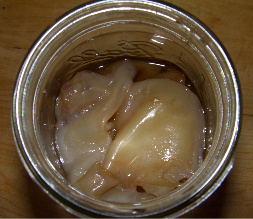
A kombucha mother in a jar with kombucha
And lastly, the kombucha mother. The mother provides most of the bacteria and yeast that your sweet tea will need for fermentation. People get mothers from a variety of sources. I got mine from a friend. You can get one from me– see Kombucha Mothers Available. You can search online for other places from which to order one. You can buy one through ebay.
Or, you can grow your own kombucha mother. If you look at my Kombucha Blooper #1, you’ll see that I didn’t have much luck with this. But, it is a simple process and probably works fine if you don’t get your brew too hot, like I did. Check out this video on YouTube for instructions: http://www.youtube.com/watch?v=3k2nq_Iz-ew
Method:
Pour water into a stainless steel pot. Add sugar. Heat the water and sugar, stirring occasionally until it boils. Remove the pot from the heat. Add the tea, and stir gently. Let the tea steep in the pot for 15 minutes. Strain the tea leaves or remove the tea bags. Allow the sweet tea to cool until comfortable to touch or cold. Pour the cooled sweet tea into your fermenting vessel. Place the kombucha mother on top of the sweet tea with the smooth surface facing up.
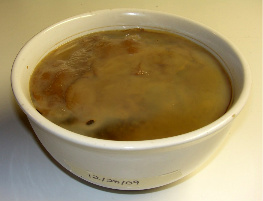
A kombucha mother on top of sweet tea
Gently pour the kombucha over the mother. Place a dishtowel or rag over your fermenting vessel and cover completely. Secure the cover with an elastic band or string (this will keep fruit flies out of your brew). Set the vessel in a warm place where it will be undisturbed. After about three days, using a plastic spoon, gently push aside the mother and sample the brew. Everyone gets to decide when their kombucha is ready. I bottle my kombucha when it is sparkling with a distinct acidity and mild sweetness, and the flavor of the tea tannins has faded. It can take from ten days to about a month for my kombucha to reach this stage, but the length of time will vary depending on your preference, temperature, and microbe population.
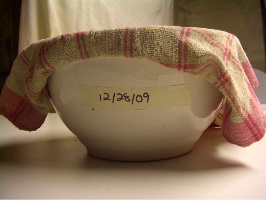
Covered and dated bowl with all kombucha ingredients
Once your kombucha is ready, you can either bottle it or put it right in the fridge. I love experimenting with flavors and secondary fermentation times, so I always bottle mine. I also really enjoy the fizz, which will increase and be sustained with bottling. If you fridge your brew right away, it will maintain any fizz for a little while like an open bottle of seltzer would, but eventually it will go flat.
If you are interested in bottling your brew, please see Kombucha Bottling. Bottling is kind of a fussy process, but the results are worth the effort.


